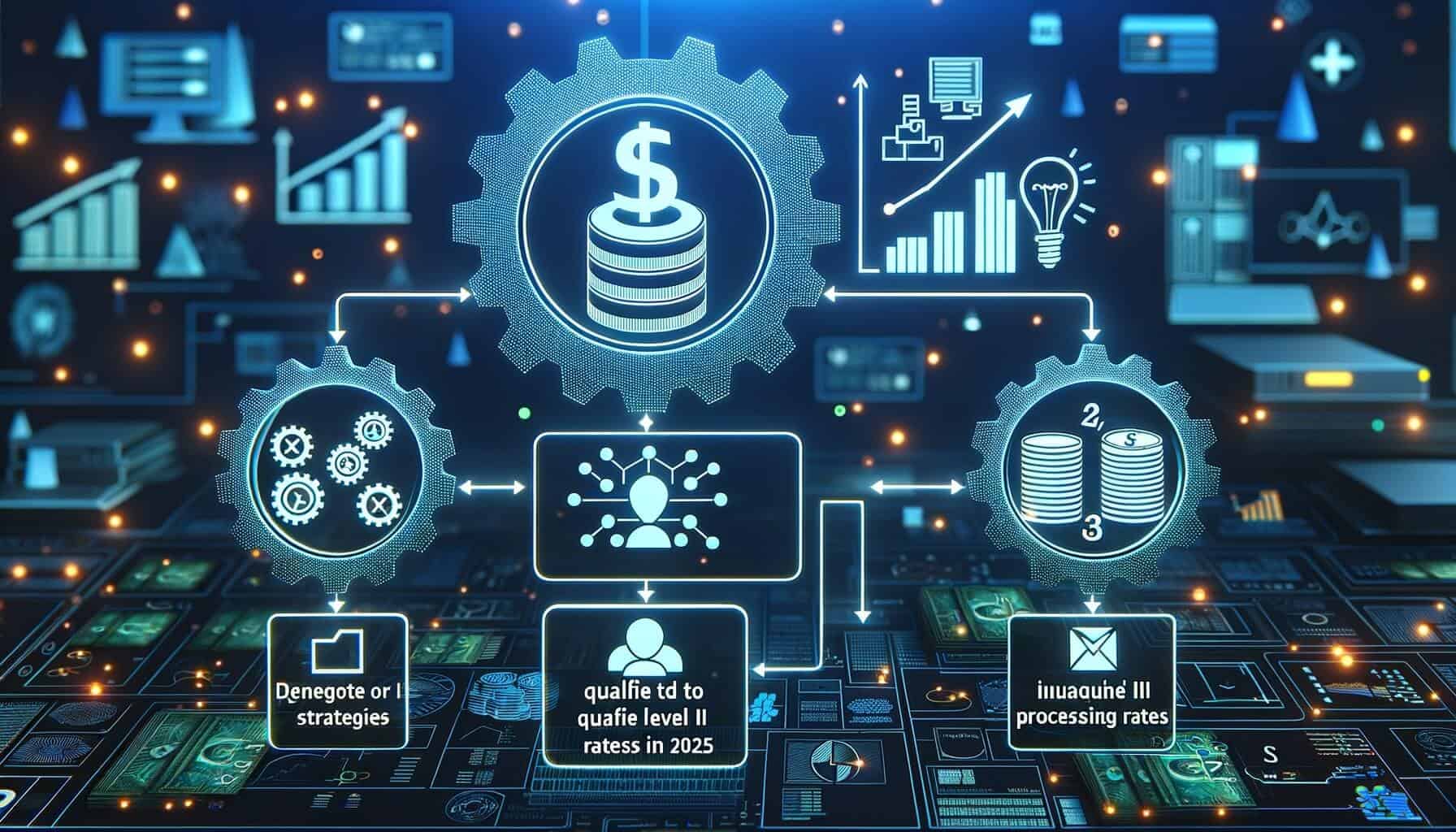
By Barbara Thomas April 23, 2025
In the ever-evolving world of payment processing, businesses are constantly seeking ways to optimize their operations and reduce costs. One such avenue is qualifying for Level III processing rates, which can provide significant savings for businesses that process a high volume of business-to-business (B2B) transactions.
In this comprehensive guide, we will delve into the intricacies of Level III processing rates, including what they are, the benefits of qualifying for them, the eligibility criteria, and the steps businesses can take to qualify. We will also explore the data requirements for Level III processing and provide tips to optimize this data for qualification.
Additionally, we will address common challenges faced by businesses in qualifying for Level III processing rates and offer solutions to overcome them. By the end of this guide, businesses will have a thorough understanding of Level III processing rates and the steps they can take to qualify for them in 2025.
What are Level III Processing Rates?
Level III processing rates refer to a specific pricing structure offered by payment processors for B2B transactions. Unlike traditional processing rates, Level III rates are typically lower and are designed to incentivize businesses to provide more detailed transaction data.
This data includes line-item details such as product descriptions, quantities, unit prices, and other relevant information. By providing this additional data, businesses can qualify for lower interchange fees, resulting in significant cost savings.
Benefits of Qualifying for Level III Processing Rates

Qualifying for Level III processing rates offers several benefits for businesses. Firstly, it allows businesses to reduce their overall transaction costs. The lower interchange fees associated with Level III rates can result in substantial savings, especially for businesses that process a high volume of B2B transactions. Secondly, Level III processing rates can improve cash flow for businesses.
By reducing transaction costs, businesses can allocate more resources to other areas of their operations, such as marketing, research and development, or employee training. Lastly, qualifying for Level III processing rates can enhance a business’s competitiveness in the B2B market. By offering lower prices to customers, businesses can attract more clients and gain a competitive edge over their rivals.
Eligibility Criteria for Level III Processing Rates

While the benefits of Level III processing rates are enticing, not all businesses are eligible to qualify for them. Payment processors typically have specific eligibility criteria that businesses must meet to access these rates. The exact criteria may vary between processors, but some common requirements include:
1. Business Type: Level III processing rates are primarily available to businesses that engage in B2B transactions. This includes wholesalers, distributors, manufacturers, and other businesses that sell products or services to other businesses.
2. Transaction Volume: Businesses must have a significant volume of B2B transactions to qualify for Level III processing rates. Payment processors may set a minimum threshold for the number of transactions or a minimum dollar amount of B2B sales.
3. Data Requirements: To qualify for Level III processing rates, businesses must be able to provide the necessary transaction data. This includes line-item details such as product descriptions, quantities, unit prices, and other relevant information. Businesses must have the capability to capture and transmit this data to their payment processor.
4. Payment Processor Compatibility: Not all payment processors offer Level III processing rates. Businesses must ensure that their chosen payment processor supports Level III processing and is willing to provide these rates.
Steps to Qualify for Level III Processing Rates

Now that we understand the eligibility criteria for Level III processing rates, let’s explore the steps businesses can take to qualify for these rates:
1. Research Payment Processors: Start by researching payment processors that offer Level III processing rates. Look for processors that have a good reputation, competitive pricing, and excellent customer service. Consider reaching out to their sales representatives to discuss your business’s specific needs and inquire about their Level III processing offerings.
2. Assess Transaction Volume: Evaluate your business’s transaction volume to determine if it meets the minimum requirements set by payment processors. If your volume falls short, consider strategies to increase your B2B sales. This could include targeting new B2B customers, offering incentives for larger orders, or exploring partnerships with other businesses.
3. Upgrade Payment Systems: Ensure that your payment systems are capable of capturing and transmitting the necessary Level III data. If your current systems are outdated or incompatible, consider upgrading to a payment solution that supports Level III processing. This may involve investing in new hardware or software, but the long-term cost savings can outweigh the initial investment.
4. Train Staff: Educate your staff on the importance of capturing accurate and detailed transaction data. Train them on how to input the necessary information into your payment systems and emphasize the benefits of qualifying for Level III processing rates. Regularly review and monitor their performance to ensure compliance with data requirements.
5. Test and Optimize Data Transmission: Before fully implementing Level III processing, conduct thorough testing to ensure that your payment systems are accurately capturing and transmitting the required data. Work closely with your payment processor to troubleshoot any issues and optimize the data transmission process. This may involve making adjustments to your systems or seeking technical support from your payment processor.
Understanding Level III Data Requirements

To qualify for Level III processing rates, businesses must provide detailed transaction data. This data includes line-item details such as product descriptions, quantities, unit prices, and other relevant information. The purpose of this data is to provide a comprehensive view of the transaction, allowing payment processors to assess the risk associated with the transaction and determine appropriate interchange fees. Here are the key data requirements for Level III processing:
1. Product Descriptions: Each line item in the transaction must have a clear and accurate description of the product or service being sold. This description should provide enough information for the payment processor to understand the nature of the transaction.
2. Quantities: Businesses must specify the quantity of each product or service being sold. This allows payment processors to calculate the total value of the transaction accurately.
3. Unit Prices: The unit price of each product or service must be provided. This information is crucial for determining the total value of the transaction and assessing the interchange fees.
4. Tax Information: Businesses must include any applicable taxes in the transaction data. This ensures that the payment processor can accurately calculate the total value of the transaction and apply the appropriate interchange fees.
5. Customer Information: The transaction data should include relevant customer information, such as the customer’s name, address, and contact details. This information helps payment processors verify the legitimacy of the transaction and mitigate the risk of fraud.
Tips to Optimize Level III Data for Qualification
To maximize the chances of qualifying for Level III processing rates, businesses should optimize their data collection and transmission processes. Here are some tips to help businesses optimize their Level III data:
1. Implement Robust Data Collection Systems: Invest in payment systems that have built-in capabilities for capturing Level III data. These systems should be user-friendly and intuitive, making it easy for staff to input the required information accurately.
2. Standardize Product Descriptions: Develop a standardized format for product descriptions to ensure consistency across transactions. This can help payment processors quickly understand the nature of the transaction and assess the associated risk.
3. Automate Data Entry: Explore automation options to streamline the data entry process. This can include integrating your payment systems with your inventory management or accounting software to automatically populate transaction data. Automation reduces the risk of human error and improves efficiency.
4. Regularly Update Pricing Information: Ensure that your unit prices are up to date and reflect any changes in your pricing structure. Regularly review and update your pricing information to avoid discrepancies in your Level III data.
5. Train Staff on Data Entry Best Practices: Provide comprehensive training to your staff on data entry best practices. Emphasize the importance of accuracy and attention to detail when inputting transaction data. Regularly review and monitor their performance to ensure compliance with data requirements.
Common Challenges and Solutions in Qualifying for Level III Processing Rates
While qualifying for Level III processing rates can be highly beneficial, businesses may encounter challenges along the way. Here are some common challenges faced by businesses and solutions to overcome them:
1. Limited Transaction Volume: If your business does not meet the minimum transaction volume requirements, consider implementing strategies to increase your B2B sales. This could include targeting new customers, offering incentives for larger orders, or exploring partnerships with other businesses.
2. Outdated Payment Systems: If your current payment systems are incompatible with Level III processing, consider upgrading to a solution that supports this functionality. While there may be an initial investment, the long-term cost savings can outweigh the upfront costs.
3. Staff Training and Compliance: Ensure that your staff are trained on data entry best practices and understand the importance of capturing accurate and detailed transaction data. Regularly review and monitor their performance to ensure compliance with data requirements.
4. Technical Issues: If you encounter technical issues with your payment systems or data transmission process, work closely with your payment processor to troubleshoot and resolve the problems. Seek technical support from your payment processor if needed.
5. Lack of Payment Processor Support: If your current payment processor does not offer Level III processing rates, consider exploring other options. Research payment processors that specialize in B2B transactions and offer competitive Level III processing rates. Reach out to their sales representatives to discuss your business’s specific needs and inquire about their offerings.
Frequently Asked Questions (FAQs)
Q1. What are Level III processing rates?
A1. Level III processing rates refer to a specific pricing structure offered by payment processors for B2B transactions. These rates are typically lower than traditional processing rates and are designed to incentivize businesses to provide more detailed transaction data.
Q2. How can qualifying for Level III processing rates benefit my business?
A2. Qualifying for Level III processing rates can help businesses reduce transaction costs, improve cash flow, and enhance competitiveness in the B2B market.
Q3. What are the eligibility criteria for Level III processing rates?
A3. The eligibility criteria for Level III processing rates may vary between payment processors but commonly include business type, transaction volume, data requirements, and payment processor compatibility.
Q4. How can I qualify for Level III processing rates?
A4. To qualify for Level III processing rates, businesses should research payment processors that offer these rates, assess their transaction volume, upgrade payment systems if necessary, train staff on data entry best practices, and optimize data transmission processes.
Q5. What data is required for Level III processing?
A5. Level III processing requires businesses to provide detailed transaction data, including product descriptions, quantities, unit prices, tax information, and customer information.
Conclusion
In conclusion, qualifying for Level III processing rates can provide significant cost savings and competitive advantages for businesses that process a high volume of B2B transactions. By understanding the intricacies of Level III processing rates, businesses can take the necessary steps to qualify for these rates in 2025. This comprehensive guide has explored the definition and benefits of Level III processing rates, the eligibility criteria, and the steps businesses can take to qualify.
Additionally, we have discussed the data requirements for Level III processing and provided tips to optimize this data for qualification. By addressing common challenges and offering solutions, businesses can overcome obstacles and unlock the benefits of Level III processing rates. With careful planning and implementation, businesses can position themselves for success in the B2B market and achieve significant cost savings through Level III processing rates.